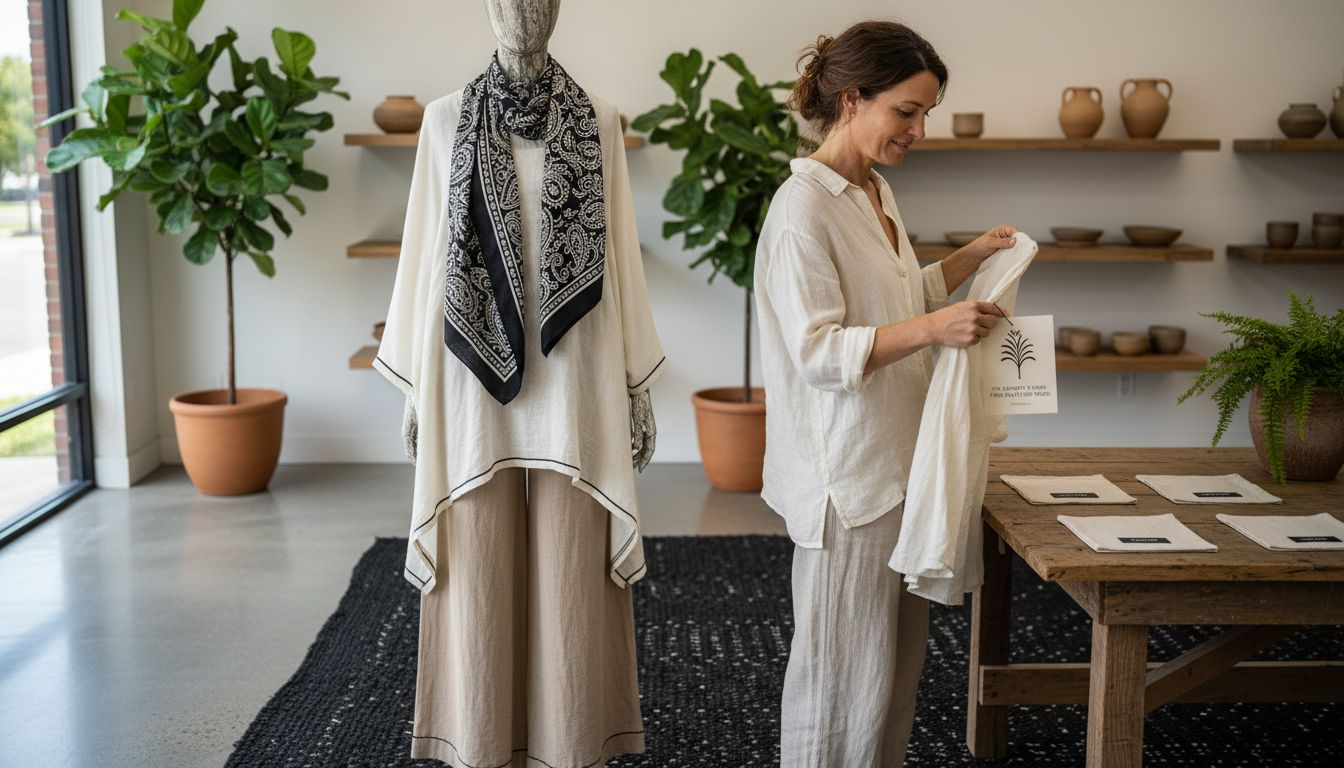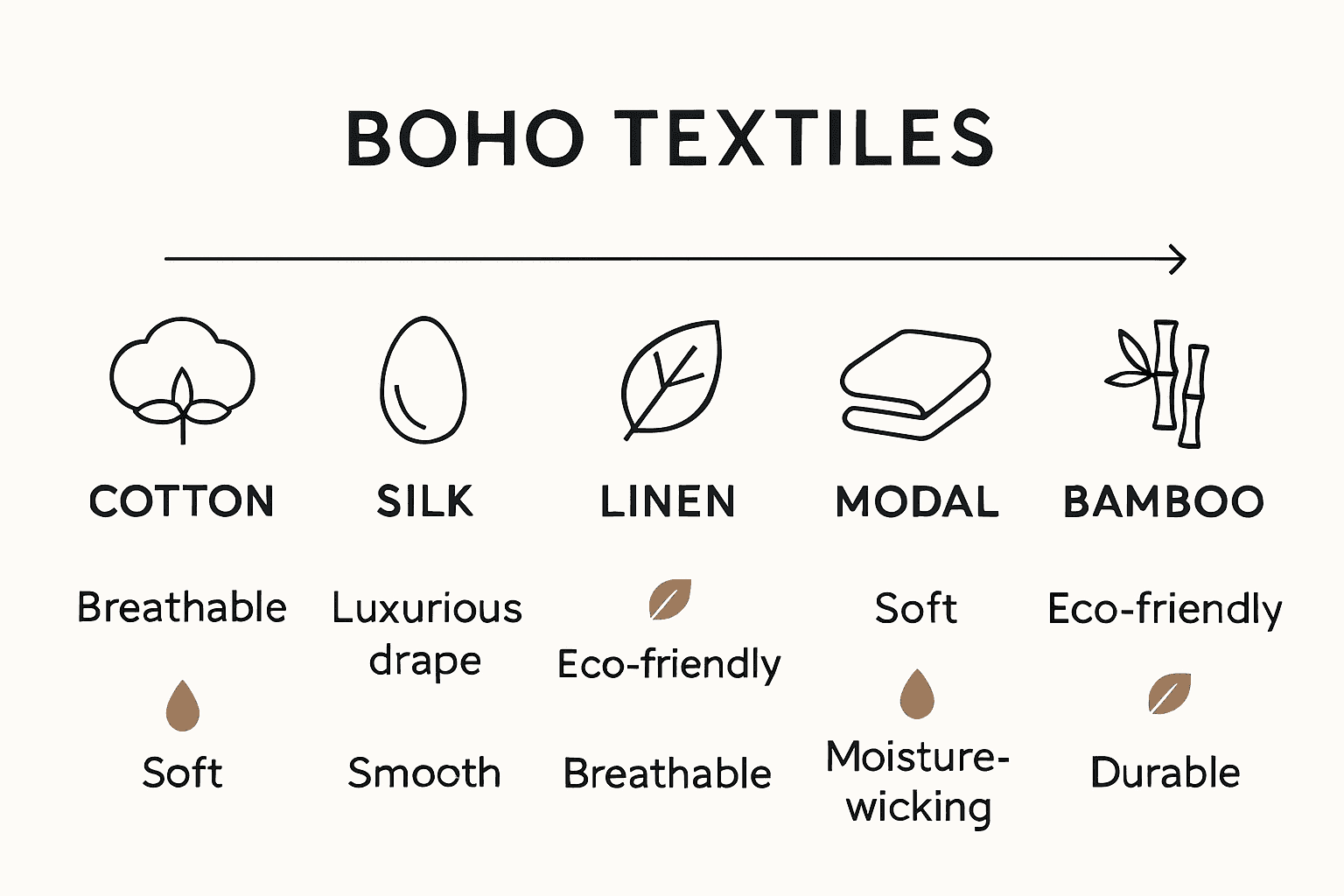
Fabric Choices in Boho: Complete Guide
Share
Did you know that over 60 percent of boho lovers prefer natural fibers like cotton and linen for their timeless comfort? Choosing the right fabric is more than a design choice, it shapes how you feel and express yourself each day. With so many options to explore, understanding boho fabric essentials helps you find materials that capture freedom, softness, and a unique sense of style true to the bohemian spirit.
Table of Contents
- Defining Boho Fabric Essentials
- Natural vs Sustainable Materials
- Textiles That Define Boho Style
- Handcrafted & Ethnic Fabric Options
- Fabric Functionality and Styling Tips
Key Takeaways
| Point | Details |
|---|---|
| Fabric Philosophy | Boho fashion prioritizes natural fibers like cotton, linen, and silk, emphasizing comfort and ecological consciousness. |
| Natural vs Sustainable | It’s essential to differentiate between natural and sustainable materials; the former is plant or animal-derived, while the latter reduces environmental impacts through responsible production methods. |
| Textile Characteristics | Key boho textiles such as cotton and silk contribute to a relaxed aesthetic characterized by lightweight, breathable, and organic materials. |
| Cultural Significance | Handcrafted and ethnic fabrics enrich boho style, supporting artisan communities and preserving cultural artistry through authentic textile choices. |
Defining Boho Fabric Essentials
Boho fashion isn’t just about patterns and free-flowing designs - it’s fundamentally about fabric philosophy. According to cdnc, boho fashion inherently favors natural fibers that embody comfort, breathability, and ecological consciousness.
The core of boho fabric selection revolves around materials that tell a story. Natural textiles like cotton, linen, and silk aren’t merely fabric choices - they’re expressions of a lifestyle that values authenticity and connection with nature. Cienna Designs emphasizes that these fabrics represent more than aesthetic appeal; they capture the laid-back, free-spirited essence of boho style.
When exploring boho fabric essentials, consider these key characteristics:
- Soft, fluid textures that move gracefully
- Natural, breathable materials
- Earth-toned or organically patterned surfaces
- Lightweight and comfortable compositions
The ultimate goal of boho fabric selection goes beyond visual appeal.
 It’s about creating garments that feel like a second skin - comfortable, unrestricted, and deeply personal. Whether you’re selecting a flowing maxi dress or a relaxed summer top, the fabric becomes your primary storytelling medium. Why Choose Boho Fashion: Complete Style Guide provides additional insights into how fabric choices reflect the broader boho aesthetic and philosophy.
It’s about creating garments that feel like a second skin - comfortable, unrestricted, and deeply personal. Whether you’re selecting a flowing maxi dress or a relaxed summer top, the fabric becomes your primary storytelling medium. Why Choose Boho Fashion: Complete Style Guide provides additional insights into how fabric choices reflect the broader boho aesthetic and philosophy.
Natural vs Sustainable Materials
In the world of boho fashion, understanding the nuanced difference between natural and sustainable materials is crucial for conscious consumers. According to MDPI, consumers demonstrate a strong preference for natural fibers like wool and cotton, primarily due to their inherent comfort and perceived environmental benefits.
Sustainable fabrics take this concept further. Textiles School highlights that truly sustainable textiles go beyond mere natural origin. These materials are derived from renewable resources and produced without harmful chemicals, representing a holistic approach to ecological responsibility.
Key distinctions between natural and sustainable materials include:
- Natural materials: Derived directly from plant or animal sources
- Sustainable materials: Produced with minimal environmental impact
- Organic cultivation methods
- Reduced chemical processing
- Lower carbon footprint
For boho fashion enthusiasts, the choice isn’t just about aesthetics - it’s a statement of environmental values.
VIDEO:video_content] By selecting materials that are both naturally derived and sustainably produced, you’re contributing to a fashion ecosystem that respects both personal style and planetary health. [Why Choose Boho Fashion: Complete Style Guide offers further exploration of how fabric choices reflect broader lifestyle philosophies.
Textiles That Define Boho Style
Boho style is intrinsically linked to its textile choices, creating a unique visual and tactile language that speaks volumes about personal expression. Cienna Designs emphasizes that natural fabrics like cotton and silk are fundamental to capturing the relaxed, flowing aesthetic that defines boho fashion.
Lightweight, breathable, and organic materials form the cornerstone of authentic boho textile selection. These fabrics aren’t just about appearance - they’re about creating a sensory experience that reflects freedom, comfort, and individual creativity. From gossamer-thin cotton gauze to richly textured silk, each textile tells a story of movement, versatility, and unstructured elegance.
Key textiles that epitomize boho style include:
Here’s a summary comparing key boho textiles and their characteristics:
| Textile | Key Features | Typical Benefits |
|---|---|---|
| Cotton | Soft Breathable Versatile |
Comfort Easy Care |
| Silk | Fluid Luxurious sheen |
Elegant drape Lightweight |
| Linen | Crisp Natural wrinkles |
Cool feel Airy texture |
| Modal | Sustainable Excellent drape |
Ultra-soft Eco-friendly |
| Bamboo | Lightweight Eco-conscious |
Exceptional softness Breathable |
- Cotton: Soft, breathable, and endlessly versatile
- Silk: Fluid, luxurious, with a natural sheen
- Linen: Crisp, cool, with beautiful natural wrinkles
- Modal: Ultra-soft, sustainable fabric with incredible drape
- Bamboo: Eco-friendly, lightweight, with exceptional softness
Understanding these textiles goes beyond mere fabric selection - it’s about embracing a philosophy of comfort and self-expression.
 Boho Summer Essentials: Complete Guide for 2024 offers additional insights into how these fabrics can transform your wardrobe and reflect your unique bohemian spirit.
Boho Summer Essentials: Complete Guide for 2024 offers additional insights into how these fabrics can transform your wardrobe and reflect your unique bohemian spirit.
Handcrafted & Ethnic Fabric Options
Boho fashion celebrates cultural heritage through its profound appreciation for handcrafted textiles and traditional craftsmanship. Cienna Designs highlights the significance of techniques like Kantha embroidery and vintage saris, which represent more than mere fabric - they’re living narratives of artistic tradition and cultural expression.
Ethnic fabrics bring depth, texture, and storytelling to boho style. Each handwoven textile carries centuries of cultural knowledge, transforming simple garments into intricate expressions of global artistic traditions. From Indian block prints to Mexican embroidered textiles, these fabrics transcend mere clothing and become wearable art that speaks to personal identity and global connection.
Exceptional handcrafted fabric options include:
- Kantha: Bengali embroidered textiles with intricate running stitch designs
- Batik: Indonesian wax-resist dyeing technique creating complex patterns
- Ikat: Intricate weaving method with blurred, dreamlike geometric designs
- Shibori: Japanese indigo dyeing technique with distinctive resist patterns
- Suzani: Central Asian embroidered textiles featuring floral and geometric motifs
By choosing handcrafted and ethnic fabrics, you’re not just selecting a textile - you’re supporting artisan communities and preserving traditional craftsmanship. Affordable Boho Fashion: Complete Guide can help you explore how to incorporate these meaningful textiles into your wardrobe without breaking the bank.
Fabric Functionality and Styling Tips
Cienna Designs emphasizes that natural fabrics like cotton and silk are cornerstone materials in boho fashion, prized for their exceptional comfort and breathability. These fabrics aren’t just about looking good - they’re about creating a sensory experience that allows your body to move and breathe with effortless grace.
Understanding fabric functionality means recognizing how different textiles interact with your body and movement. Lightweight, fluid materials create the quintessential boho silhouette - think gracefully draped layers that flow and shift with every step. The magic of boho styling lies in choosing fabrics that don’t just cover your body, but actually complement and enhance your natural movement.
Key fabric functionality considerations include:
- Drape: How elegantly the fabric falls and moves
- Breathability: Allowing air circulation and temperature regulation
- Texture: Creating visual and tactile interest
- Layering Potential: Ability to mix and combine different fabrics
- Comfort: Ensuring unrestricted movement and all-day wearability
Styled thoughtfully, your fabric choices become a form of personal expression. Mixing textures, playing with transparent and opaque layers, and selecting materials that tell a story are fundamental to authentic boho fashion. Affordable Boho Fashion: Complete Guide provides additional insights into mastering this nuanced approach to textile selection and styling.
Discover Your Perfect Boho Fabric Style with BohoCloud
Choosing the right fabric for your boho wardrobe can feel overwhelming when you want comfort, sustainability, and authentic style all in one. The challenge lies in finding materials that embrace the boho spirit with natural breathability and effortless drape while supporting your values. At BohoCloud, we understand your desire for clothing that feels like a second skin and showcases your individuality through earthy textures and free-flowing designs.
Explore our carefully curated Tops – Boho Cloud collection to find garments crafted from soft, breathable fabrics like cotton and linen that bring the relaxed, elegant boho silhouette to life.

Elevate your wardrobe today with pieces that combine style, comfort, and conscious choices. Dive into the world of boho-chic fashion at BohoCloud and let your fabric choices tell your story. For a complete boho look, don’t forget to explore our unique Accessories – Boho Cloud that beautifully complement your outfit. Embrace the freedom to express yourself while acting now to experience fashion that moves with you and supports your values.
Frequently Asked Questions
What are the essential fabrics for boho fashion?
Boho fashion primarily utilizes natural fabrics such as cotton, linen, and silk. These materials embody comfort, breathability, and ecological consciousness, contributing to the relaxed aesthetic of boho style.
How do natural materials differ from sustainable materials in boho fashion?
Natural materials are those derived directly from plant or animal sources, like cotton and wool. Sustainable materials go a step further by being produced with minimal environmental impact, often using organic cultivation methods and reducing chemical processing.
What characteristics define boho textiles?
Boho textiles are characterized by lightweight, breathable, and organic materials. They often feature soft, fluid textures, earthy tones, and natural patterns, enhancing comfort and personal expression in boho style.
Why are handcrafted and ethnic fabrics important in boho fashion?
Handcrafted and ethnic fabrics celebrate cultural heritage and traditional craftsmanship. Textiles such as Kantha and Batik carry rich cultural narratives and support artisan communities, making them meaningful choices for those embracing the boho aesthetic.
